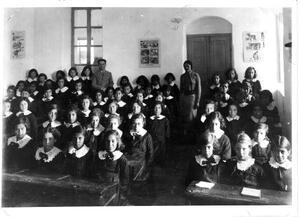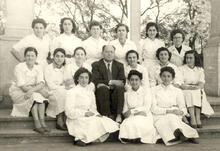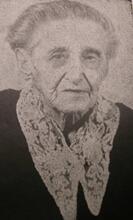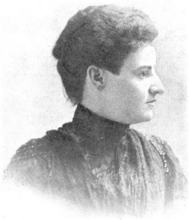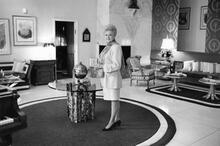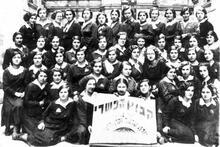Alliance Israélite Universelle, Teachers of
Girls school run by the Alliance Israélite Universelle, Jerusalem, 1935. Via Wikimedia Commons.
Founded in 1860 by six French Jewish intellectuals, the Alliance Israélite Universelle strove to bring western and modern ideals to Jewish children through schools around the world. Teachers of the Alliance were sent to schools that often had few resources and offered poor living conditions, but the teachers largely succeeded in their mission. The Alliance included both male and female teachers, but the women in particular criticized the Alliance leaders’ patronizing attitudes and limited intentions concerning education in the Middle East. The female teachers of the Alliance not only fulfilled the organization’s missions, but more broadly contributed to changing the emancipationist ideology of French Jewry to better reflect the needs of young Jewish women.
Founding and Mission
In 1860, six French Jewish intellectuals, inspired by the ideals of the Enlightenment and motivated by a genuine sentiment of solidarity, set out to “regenerate” the Jews of the world—vocationally, linguistically, morally, and spiritually. By the eve of World War I, the international organization they founded, the Alliance Israélite Universelle, had attracted more than 30,000 members. Its 183 schools, stretching from Tetuan in Morocco to Teheran in Iran, boasted a student population of 43,700.
French was the language of instruction in all these schools. The curriculum included biblical and post-biblical history, religious instruction, Hebrew, French, arithmetic, local and world geography, local and world history, physical and natural sciences, the local language (for example Turkish, Greek, Arabic, or Spanish), linear design, and, for girls, sewing. Most of the schools were primary, some co-educational, and a few vocational.
Training of Teachers
The Alliance had originally expected its teachers to come from France. Few French Jews, however, were willing to live in the villages and towns of North Africa and the Middle East. In a move as radical as it was pragmatic, the Alliance opted for an alternative strategy—to send the brightest of the “Orientals” to study in Paris. Four years later, with French teaching degrees and having passed examinations in Hebrew and Jewish history, these young men would be sent back to “educate the children of their country,” to eradicate their “bad habits” and to inspire “love of country … love of truth …dignity of character….and the spirit of sacrifice for the common good.” In short, they were to prepare less fortunate co-religionists for citizenship in their own countries. By 1872, women were also included in the Alliance teaching force.
The École Normale Israélite trained all male Alliance teachers. Young girls arriving in Paris, however, were sent either to the École Bischoffsheim, a vocational and normal school, or to the private schools of Madame Weill-Kahn or Madame Isaac. All three of these schools offered their girls a rigorous education in physical and natural sciences, ancient history and ancient literature, geography, arithmetic, French and English, as well as Hebrew, the Bible, and Jewish history. Complementing the academic studies were courses in gymnastics, design, and the cutting of garments.
Although the demands on the “Orientals” were onerous (with two years less preparation than their Parisian classmates they were expected to take the same written and oral exams at the Hôtel de Ville), this did not cloud their warm devotion to the Alliance. “The holiday of The Jewish New Year, held on the first and second days of the Hebrew month of Tishrei. Referred to alternatively as the "Day of Judgement" and the "Day of Blowing" (of the shofar).Rosh Ha-Shanah is for us a unique occasion to express to you our sincere feelings,” the students at Mme Isaac’s wrote to the Alliance on September 25, 1908. “We are not unaware of how much you care for us. Although separated from our parents, thanks to your protection we do not find ourselves so alone.” By the time these young women prepared to depart from Paris, often never to return, the country of their benefactors had also become, as one class explained, “a little bit ours.”
Experiences in Alliance Schools
Alliance teachers entered a profession for which no amount of education was adequate preparation. Tapping what appear to be boundless reserves of independence and self-confidence, they had first to acquaint themselves with their new “home,” find a place to live, and, with very little funding, furnish it. Their first assignment, often as an assistant, rarely matched their youthful expectations. This was certainly the case for Lucie Ovadia, who had come to Paris in 1896 from Salonika. A fine student who Madame Isaac believed would make an excellent teacher, the twenty-year-old Lucie was sent to Alexandria in 1899, just two years after the Alliance opened its schools for girls and boys.
“I am determined,” Lucie wrote shortly before leaving Salonika for Alexandria, “to carry out well the task which the Alliance has assigned me.” But once she arrived in Egypt, Lucie found herself confined to a tiny room with inadequate furnishings, teaching in a school which its director described as dirty and unhygienic, and confronting, in addition to the “deplorable conditions,” a lack of supplies and a problematic student body.
Each time a teacher was transferred, sometimes after only a few years and not always to locations she desired (for example, Lucie was sent to Rhodes and subsequently to nearby Bursa), she again faced familiarizing herself with the language and customs of her students as well as ensuring satisfactory living conditions for herself and, as time went on, for her growing family.
When the Alliance leadership decided that its women teachers should be permitted to marry is not clear. By the time debates in Europe concerning the wisdom of teachers marrying were featured in the pages of the Alliance’s Bulletin des Écoles (1910), marriages were a fait accompli and large families the norm. Predictably, women teachers married their male counterparts. Lucie, for example, met Léon Sémach at the school in Bursa where he was the director. Claire Benchimol returned to Tetuán (Tétouan) and married Maïr Lévy, whom she had known as a child but who was also a teacher in the boys’ school. Of the 194 women teachers who received their degrees in Paris before 1935 and who served the Alliance for at least ten years, 127 married. In addition, others married after they left the Alliance or left the Alliance in order to marry.
Women Teachers
Needless to say, the women teachers of the Alliance were a diverse group. They differed in background, language, and piety as well as in temperament and intellect. Lucie Ovadia’s classmates at Mme Isaac’s, for example, came from cities as far apart as Constantinople, Adrianople, the Dardanelles, Tangier, Monastir, Alsace, Aleppo, Damascus, Aden, Beirut, and Salonika. Their experiences were equally diverse, for the positions they were assigned and the cities to which they were sent rarely had much in common. Moreover, they were rarely sent to their places of origin. Furthermore, the expectations placed on them continued to change as the number of schools increased dramatically and the ties to colonial authorities became more intrusive. Nevertheless, in spite of daunting responsibilities and their own contested identities, the women teachers of the Alliance largely succeeded in their tasks. Even more, they successfully re-defined just what these tasks were, thus revealing the revolutionary implications of the Alliance’s far more limited intentions.
Both Claire and Hassiba Benchimol, for example, appalled by the practice of child marriages, determined to eradicate them. Tellingly, the situations in Tetuán and Fez were very different: in Tetuán, the practice existed only among the poorer members of the community, while in Fez, child marriages remained the preserve of the wealthy. But for both Claire and Hassiba the remedy was the same—to convince the mothers to give priority to the education of their daughters rather than insuring a suitable marriage partner.
Significantly, there existed among the women teachers of the Alliance an expression of solidarity neither anticipated nor articulated by its founders, a solidarity that led them to highlight and praise the essential role played by women in economically and spiritually sustaining their families. The Tripolitanian woman, Alégrina Benchimol informed the Alliance, is intelligent, extraordinarily active, and has an indomitable energy. “In the years of darkest misery, while the husband sought to forget his severe trials in some city cabaret, she dared to confront them. She is at the same time mother, manager and support of the family. She is always encouraging her children or her husband…by her presence and her example.”
Experience of Women Teachers
In contrast to many of their male counterparts, women teachers consistently chastised the Alliance leaders for their patronizing attitudes and their limited intentions concerning education “in the Orient.” After a particularly heated disagreement with Jacques Bigart, sécrétaire général of the Alliance, over the teaching of history, Claire Benchimol acquiesced, but not before assuring the Alliance that her methods, not theirs, would ensure autonomy, self-esteem, and economic independence for her young girls. And when Bigart refused to accept one of her students to study in Paris, Claire had little trouble suggesting that this response indicated a prejudice against accepting any students from Tripoli. “I see that this is a systematic refusal and to reasons of age alleged in your first letter are now joined those of academic weakness…. No doubt the student whom I propose to you is not a phoenix, but her intelligence and her work are at least at the level of those many candidates whom you had admitted for me from Tetuán.”
Significantly, women teachers in the field also criticized the Alliance for failure of nerve. Messody Pariente, for example, wrote to Bigart in 1907 from her post in Mazagan: “You express fear for the security of a young girl who would come all alone to Morocco. She would not be alone. She would be with me, staying with me if it is necessary…. This lack of tranquility could last for years. Is it because of this that you are going to suspend your work in Morocco? We must continue to work there, now more than ever; it will not be difficult to find in your personnel a young girl courageous enough to accept the post in Mazagan (Al-Jadida, Morocco).”
Not surprisingly, the teaching of Hebrew presented unique problems for the women teachers. The constraints posed by the community of Fez, for example, made it difficult to find a suitable rabbi. At first Hassiba Benchimol thought she would teach the Hebrew class herself. But she quickly realized that some of her students were daughters of rabbis and knew more Hebrew than she did. We cannot engage a young rabbi for the school, she explained to Paris, or even one of middle age, for the parents would take their daughters out of the school. Finding an “old man” who in spite of his years could still work, Hassiba was frustrated both by his teaching style as well as his lack of discipline. Her remedy was to have him teach Hebrew during dressmaking under her personal surveillance.
Impact
From its inception, the Alliance publicly stated its goals of westernization and modernization. There is little doubt, however, that when mediated by its women teachers, these goals spoke less to the bourgeois ideal of forming good wives who could provide domestic peace and intellectual companionship for their husbands, than to the empowerment of young girls, intellectually, physically, professionally, and spiritually. There is equally little doubt that these women teachers were seen by their students as offering an alternative role model, one which spoke neither of poverty nor of subservience, but rather of autonomy, dignity and literacy. Finally, albeit unwittingly, the women teachers of the Alliance consistently reframed the emancipationist ideology of French Jewry to reflect more accurately the needs of Jewish girls, especially those living in Muslim lands.
Primary Sources:
The archives of the Alliance Israélite Universelle, which contain the correspondence of the teachers, are located in Paris at 45 rue La Bruyère. There is also material concerning the teachers in the Archives de Paris and the Archives Nationales.
Secondary Sources:
Benbassa, Esther and Aron Rodrigue. The Jews of the Balkans. Oxford: 1995.
Benbassa, Esther. “L‘Éducation feminine en Orient: L‘école de filles de l‘Alliance Israélite Universelle à Galata, Istanbul (1879–1912). Histoire, Economie et Société (4, 1991): 529–559
Benbassa, Esther. Une diaspora sépharade en transition. Paris: 1993
Benveniste Annie. “Le rôle des Institutrices de l‘Alliance Israélite Universelle à Salonique.” Combat Pour La Diaspora (Juin, 1982): 13–26.
Danan, Ariel. "Les instituteurs de l'Alliance israélite universelle (1860-1939) Étude à partir de l'outil informatique et statistique." Archives Juives 37, no. 1 (2004): 111-120.
Land, Joy A. Corresponding Lives: Women Educators of the Alliance Israélite Universelle School for Girls in the City of Tunis, 1882-1914. Los Angeles: University of California, 2006.
Laskier, Michael M. The Alliance Israélite Universelle and the Jewish Communities of Morocco 1862–1962. New York: 1983.
Malino, Frances. “The Women Teachers of the Alliance Israélite Universelle 1872–1940.” In Jewish Women in Histoical Perspective, edited by Judith Baskin, 248–269. 2nd ed. Detroit: 1998.
Malino, Frances. “Prophets in Their Own Land? Mothers and Daughters of the Alliance Israélite Universelle.” Nashim, Number 3, spring–summer (5760/2000): 56–73.
Rodrigue, Aron. French Jews, Turkish Jews The Alliance Israélite Universelle and the Politics of Jewish Schooling in Turkey, 1860–1925. Indiana: 1990.
Rodrigue, Aron. Images of Sephardi and Eastern Jewries in Transition: The Teachers of the Alliance Israélite Universelle, 1860–1939. Washington: 1993.
Spaeth, Valérie. "La création de l’Alliance Israélite Universelle ou la diffusion de la langue française dans le bassin méditerranéen." M.-C. Kokescalle & F. Melka (éds). Changements politiques et statuts des langues, histoire et épistémologie. Amsterdam/Atlanta: Rodopi (2001): 103-118.

